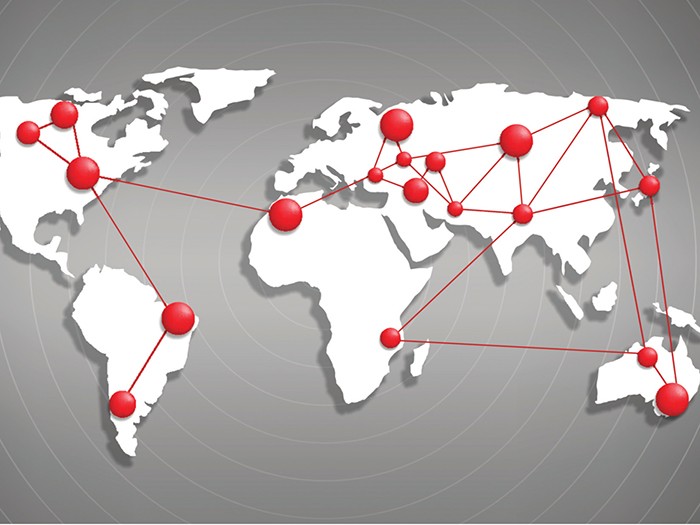COVID and the Global Supply Chain: Why the Risk Has Become Substantially More Challenging

Managing global supply chain risk has become both more important and more challenging in recent years, and the COVID-19 global pandemic has destroyed any tattered remnants that remained of the old way of supply chain risk management.
Companies widely understand that diversity of thought is integral to any team’s success, and the principle of duplication remains an important risk reduction strategy as part of an overall risk management plan. But when it comes to global supply chains, businesses have often developed only one strand on their chain — one supplier or manufacturer of a necessary component or process from raw material through production to final consumable product.
Perhaps it is the same supplier they have always used, or they have not had the time or money to invest in a strategic review of their supply chain.
Whatever the reason for the gap, it is highlighted during extreme times. We have seen cracks in the global supply chain before — for example Apple’s issues with securing vital raw materials for its iPhones that have plagued the company for several years even before the global pandemic issues of 2020 — however the weaknesses brought to light during COVID-19 have far exceeded previous small-scale supply chain issues.
Thomas Holzheu, chief economist for the Americas at Swiss Re, commented, “COVID-19 has highlighted vulnerabilities in the medical manufacturing supply chain. Government response to COVID-19 has shown that in times of crisis, international cooperation can be interrupted, as countries prioritize according to their domestic needs. As in the supply chain of several other industries, medical supply manufacturers struggled to get the raw materials for their products when the Chinese factories closed for weeks in the early stages of the pandemic.”
During the height of the outbreak in the U.S., commercial flights were interrupted, causing chaos in many supply chains. The Department of Defense was able to create an “air bridge” during this time to secure necessary medical supplies, but private companies do not have the capacity to do that.
Insecurities in the global supply chain caused by the pandemic have, for many industries, prioritized the need to diversify their supply chain.
Some ways to do this are by creating parallel supply chains; investing in domestic resources to replace foreign manufacturers; and utilizing emerging technology, such as robotics, to enhance the supply chain. These changes to the global supply chain also bring new risks that will need to be considered.
In its recently published report “De-risking global supply chains: rebalancing to strengthen resilience,” Swiss Re examines the “new normal” of supply chains in a post-pandemic world.
Researchers found new opportunities for insurers will result in around $63 billion in additional premium globally over the five-year transition period, which will include $1.2 billion out of new demands for engineering covers and $9 billion for commercial insurance to cover newly built facilities.
The report predicts greater development of parallel supply chains with new sources being built up in southeast Asia to produce alongside Chinese operations. Swiss Re also found that some repatriating of suppliers back to their home markets in the U.S., Europe and Asia will occur, as well.
Emerging Risks Created by New Supply Chains
With progress comes pain, or in this case, new risks, to be considered and managed.
New business partners and vendors could introduce novel geographic, political or exchange rate risks depending on their location.
New suppliers are an unknown — they may fail to fulfill the contract or may be mismanaged, passing those risks along to their partners. Construction of a parallel supply chain or a new manufacturing location creates construction, engineering and environmental risk during and after the build. The upcoming U.S. presidential election and Brexit-related changes in the UK may alter government policies and trade restrictions, creating supply chain challenges.
New reputation risk is created, as well.
Consumers expect companies to be transparent about their suppliers and to ensure their supply chain is free of harm, such as that of child labor or poor working conditions.
Holzheu said, “The current restructuring of the global supply chains are undermining the goal to increase transparency about upstream suppliers and downstream customers.”
Rushing to find new suppliers due to pandemic-related shortages can be problematic when little is known about the new supplier. The Swiss Re sigma report also noted that prior globalization of the supply chain brought about efficiencies that may be lost or reduced if the use of global suppliers diminishes and local sources are developed instead.
Ways to Mitigate New Supply Chain Risks
One novel way to mitigate some of these newly created risks is through the creation of digital supply networks (DSNs).
As the name implies, updates and information related to the supply chain is transmitted digitally, giving the benefit of instant knowledge-sharing between remote locations. This reduces downtime should a particular link in the supply chain fail or experience a delay; the faster others know of the failure the sooner the process can be restarted, re-routed or remedied.
The digital nature of the DSN helps solve the transparency issue, as well.
With a digital supply chain, problems, solutions and information are all readily available to consumers and business partners alike.
“Digital technologies offer a way to better understand the supply chain in terms of risk identification, assessment and monitoring,” Holzheu said. “For example, an end-to-end data platform can go a long way to reduce operational risk by ensuring data security and the sharing of critical information with all stakeholders along a supply chain.”
Insurance solutions to help mitigate supply chain risk have traditionally included business interruption and contingency business interruption coverage, non-damage business interruption, cyber, political and supply chain insurance.
Now, with more businesses moving to DSNs, cyber coverage may need to expand and could become more important than other types of coverage. Swiss Re points out the growth in alternative manufacturing processes, such as 3D printing, allowing for smaller quantity production with easier product differentiation. This could mean a change to the traditional BI policy to cover the equipment, new vendors and different materials and risks.
Agents should understand these changes to better advise their customers. &










